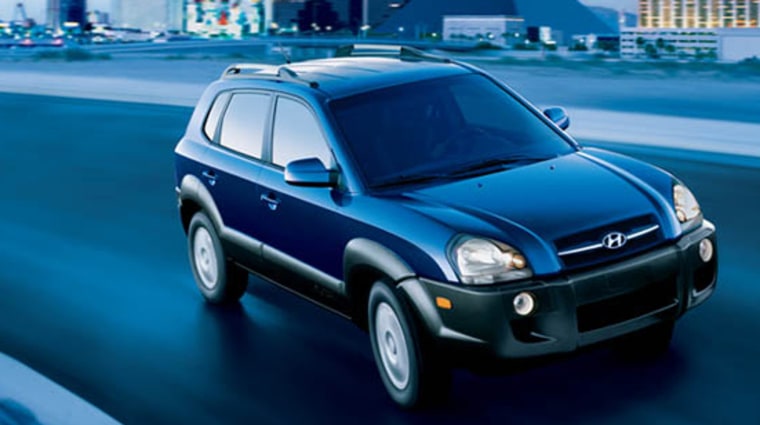It’s no secret that Japanese automakers are thrashing their U.S. rivals, producing award-winning vehicles and grabbing an ever bigger share of the North American auto market. But Japan’s venerable carmakers may soon be getting a taste of their own medicine.
South Korea’s No. 1 automaker, Hyundai Motor, scored a stunning victory with American consumers in the latest J.D. Power and Associates Initial Quality Study, placing third overall behind Porsche and Toyota’s luxury Lexus brand. It was Hyundai's best showing ever in the influential quality study, which is based on responses by just over 63,000 new car buyers and lessees, measuring defects or design problems that occur in the first 90 days of ownership.
While Japan’s Toyota dominated the J.D. Power rankings, taking the top spot in 11 of 19 model categories, Hyundai’s recognition is significant because it means the South Korean automaker is a force to be reckoned in the North American and global automobile markets, said Jack Nerad, market analyst at Kelley Blue Book.
"For the last several years, Hyundai has pitched itself as the next Toyota, and the company has high expectations of where they will rank among world’s automakers,” said Nerad. “They’ve realized that to do well in U.S. market they have to be very strong in reliability and quality perception, and they are looking to bring their brand up-market.”
“Toyota already is concerned about what Hyundai is achieving,” said Nerad. “You’re seeing (Toyota's) subcompact vehicles coming in — it’s a shot across the bow to Hyundai. They are saying, ‘We’re not leaving this market to you at Hyundai.’”
To date, Japan's Toyota, Nissan and Honda have been the leaders of Asia’s emerging dominance of the global car market, tapping into consumers’ desires for dependable, attractive and fuel-efficient cars, and picking up many of the sales lost by their shrinking American rivals.
But now Hyundai, the world's No. 6 manufacturer, is coming into its own.
While Toyota made its U.S. debut in the late 1950s, Hyundai is a relative newcomer to the American auto market, having arrived on the scene only 20 years ago. Early U.S. models like the Excel were plagued by quality problems.
In 1998, Hyundai cemented its position as Korea’s leading automaker by acquiring a majority stake in rival Kia Motors. And in recent years the manufacturer has closed the gap and then some with its rivals.
Last year Consumer Reports ranked Hyundai’s Sonata sedan, built at a plant in Montgomery, Ala., as the most reliable car in the United States. The midsize sedan, which is enjoying record sales, also scored high marks on the National Highway Traffic Safety Administration’s crash and rollover tests. And this year the Hyundai Entourage earned the Insurance Institute for Highway Safety’s best rating ever for a minivan.
Hyundai also has made its cars more attractive to drivers, striking a balance between ride quality and handling stability, said Kevin Smith, editorial director at Edmunds.com, an automotive information Web site.
“It’s easy to get one or the other, but it’s tough to get both together,” said Smith. “It takes engineering resources and a lot of investment, and it also takes setting that as a priority. Most car companies have the expertise to do this. There’s no black art to putting cars together in a way that consumers like them, but it’s clear that Hyundai has simply made the decision that they are no longer going to be the butt of jokes about reliability and dependability, and they have worked hard to successfully turned things around.”
Hyundai’s strong showing in consumer surveys and safety tests should help the company win over more consumers in coming months, said Kevin Reale, an analyst at Boston-based AMR Research.
“The Japanese are really going to have to take the South Koreans seriously now,” Reale said. “Hyundai is really up there and it’s playing with the major competitors, but it’s not there by mistake — they have put a lot of effort and time into their ability to make good cars, and they have fixed their supply chain so they can quickly rectify quality issues.”
As a result, sales are surging. Hyundai and its subsidiary Kia Motors saw an 11.6 percent jump in global sales in 2005 — the largest percentage gain of any carmaker in the million-plus sales category.
But while Hyundai is likely to continue gaining share, it probably will remain a second-tier manufacturer for the foreseeable future, said Reale.
Hyundai has a 3 percent share of the global market today, a figure that is likely to rise to 8 percent by 2015, according to consulting company CSM Worldwide, Reale said.
He expects the global auto market to shake out into two tiers over the next 10 years: A top tier with Nissan, Toyota, General Motors and Ford each holding between 10 and 15 percent, and a second tier with names like DaimlerChrysler, Honda, Volkswagen and Hyundai, each with 5 to 10 percent.
“Hyundai is definitely going to grow and capture some market share,” said Reale. “The structural shifts in automotive industry are driving this — it’s becoming more global, and automakers can build and sell their vehicles anywhere now. Worldwide light vehicle production is expected to grow from 55 million today to 84 million in 2015. That’s a significant increase that will be driven by growth that will mostly come from Asia.”
